The glorification of nature as an emotive and cerebral referent was a powerful movement that captured the attention of the European literati during the 18th century. The different iterations of this movement were regarded as a reaction to the logic of the Enlightenment and its scientific basis for apprehending the world, which left lots of commoners behind with its aristocratic pretensions.
This reactionary arts movement was dubbed Romanticism and launched by the Sturm und Drang (literally storm and urge) movement in German literature, in which emotion and feeling improbably rose to the forefront after a century of suppressing the same in favor of rational logic. Feeling swapped for thought.
.
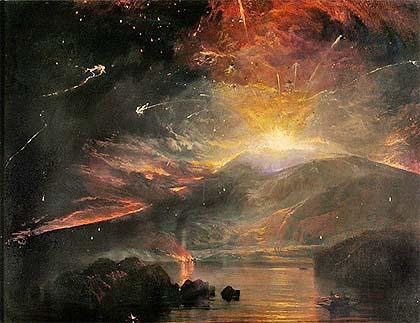
“The Eruption of the Souffrier Mountains, in the Island of St Vincent, at Midnight, on the 30th of April, 1812, from a Sketch Taken at the Time by Hugh P. Keane, Esqre” by J.M.W. Turner, exhibited 1815 at Tate Museum. Oil on canvas, 794 x 1048 mm.
.
Works by Stephen Hannock of dramatically different dimensions currently on view at the Grenning Gallery in Sag Harbor fit into the romanticist style. At 44 by 72 inches, Flooded River with Red Maple is the largest of the six paintings in the show. Incendiary Nocturne paintings range in size from 48 by 40 inches to 7.4 by 5 inches.
The Incendiary Nocturne paintings lean heavily on earlier masterworks of this era, especially the Romanticist paintings of J.M.Turner (1775-1851) whose The Eruption of the Souffrier Mountains looks as though it was painted on an adjacent easel with the same palette of burnt umber and cadmium yellow.
Periodically 18th century Romanticism is rebirthed as an addition to rational thought; a current example would be its appearance in conceptual art that can leave the mind full and the heart empty. Romanticism’s periodic reintroduction is unusual for historical styles; no one is endeavoring to rebirth Renaissance Madonna paintings. I think this is part of what makes space for, and interest in, Hannock’s paintings, as there are many others seeking to work with this older imagery and style and obviously an audience for it.
.
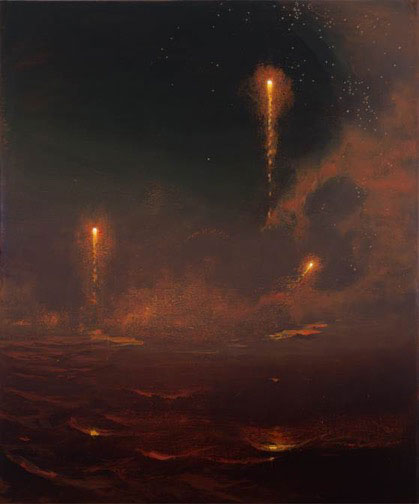
“Incendiary Nocturne with Stormy Sea” by Stephen Hannock, 2016. Oil on canvas, 48 x 40 inches.
.
A favorite theme for the Romanticists and especially Turner was the sea, and Turner recycled his stormy sea title a good many times, for instance his Stormy Sea Breaking on a Shore, 1840-5, or his Stormy Sea with Blazing Wreck, 1835.
In the Grenning show, Hannock’s “Nocturne with Stormy Sea” uses fireworks in place of the volcano eruptions that flashed across several Turner paintings. The artist’s work typically includes a body of water, which seems to be de rigueur for Romantic painters, probably because it is unspoiled by buildings that seem to deface the entire planet now. Bodies of water also appear timeless, hence the efforts of photographer Hiroshi Sugimoto, whose photos of open bodies of water capture timeless moments.
Hannock is represented by the Marlborough Gallery in New York. In the artist’s Marlborough catalog, available at the Grenning Gallery, there are 16 paintings, and each has water imagery in it. Its inclusion and the way it is represented again suggest a reference to Turner, who, if fable is to be believed, went offshore in a storm lashed to the foresail mast in order to gain personal experience of the ruckus of a wild sea. The artist’s constant use of water is also a bit formulaic; while most artists tend to be formulaic to a degree, wider variation is always welcomed.
Hannock’s work also leans toward night imagery or perhaps the raking light of dusk or dawn. This is a common feature of Romantic painters and also of photographers who prefer the more dramatic light and long shadows of the earth dimmed. But this begs the question of how one paints in the dark, since nothing is visible. Photographers use long exposures to illuminate night scenes that they cannot see at all when they are photographing, but that doesn’t work in painting. Hence the use of illumination from an erupting volcano for Turner, or the ascending fireworks pre-starburst for Hannock in the fabrication or rendering of night scenes.
.
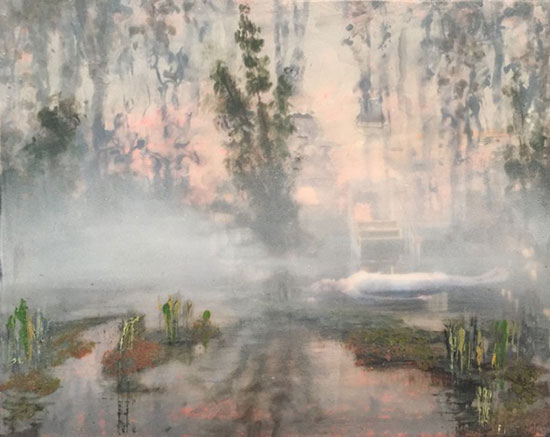
“Flooded Oxbow for Ophelia,” by Stephen Hannock, 2016. Oil on canvas, 5.5 x 6.25 inches.
.
The cover painting of the catalog is a quiet image of a crook in a river, Oxbow for Ophelia, painted apparently at sunset, given the colors in the sky. This piece contains the elements of water and moody dusk or dawn that are represented in many of Hannock’s works. It’s a quiet place to rest one’s brain after days filled with LED screens and text messages and the stress of the modern world.
Shakespeare included only two female characters in his seminal “Hamlet,” one being Ophelia; after some troubled interactions with the Danish prince, she falls from a willow tree into a brook and drowns. This literary poeticism, and it is rendered beautifully by the Bard, is also a theme that has appeared in many paintings, although not recently. The Romantic painter Sir John Everett Millais (1829-1896) painted Ophelia in 1851-1852, which became a standard for stage sets.
Hannock’s dreamy imagery in “Flooded Oxbow for Ophelia” is closer to the 1898 Ophelia by Frances MacDonald (1871-1923), prone and hazy, albeit with a second, clothed, figure by the river in the right foreground. This is a continuing theme for Hannock and we see in this show a smallish work, sans figure, entitled Waiting for Ophelia 3.
.
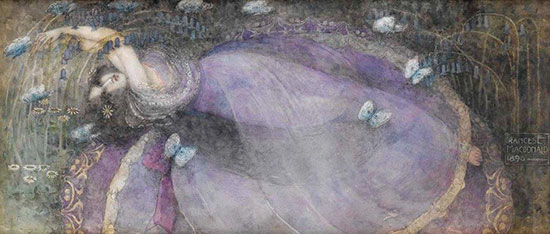
“Ophelia” by Frances MacDonald, 1898. Watercolor and pencil on paper, 17.72 x 40.16 inches.
.
“Recapitulate,” in the biology sense of the word, was a common term used in the counterculture battles of the ’60s; many psychologists believed we had erred with our urban plan and needed to walk it backwards to a more open hunter/gatherer spirit. Hence the back to the earth movements as seen in the Arcosanti campus in Arizona created by architect Paolo Soleri, and in many other communes and many places. It is this true north of nature that beckons to us despite the plenitude and economy of congested cities in which most of us live. This is Hannock’s space.
.
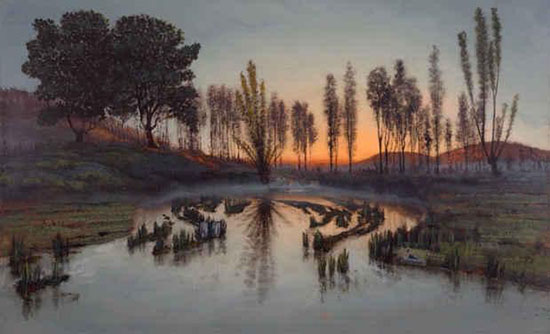
“Flooded Oxbow for Ophelia” by Stephen Hannock, 2016. Polished mixed media on canvas, 44 x 72 inches.
.
In addition to gaining representation by the Marlborough Gallery, Hannock has been busy lately showing in many venues. The artist also painted scenery for the popular Ron Bass movie “What Dreams May Come.”
_____________________________
BASIC FACTS: “Stephen Hannock Solo Show” is on view June 10 to July 3, 2017 at the Grenning Gallery, 17 Washington Street, Sag Harbor, NY 11963. www.grenninggallery.com
_____________________________
Copyright 2017 Hamptons Art Hub LLC. All rights reserved.
